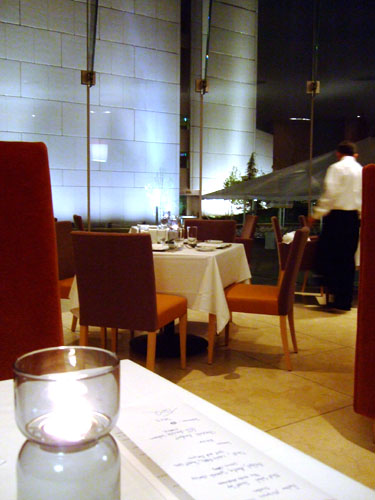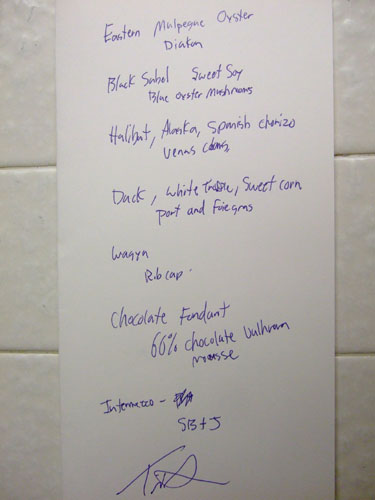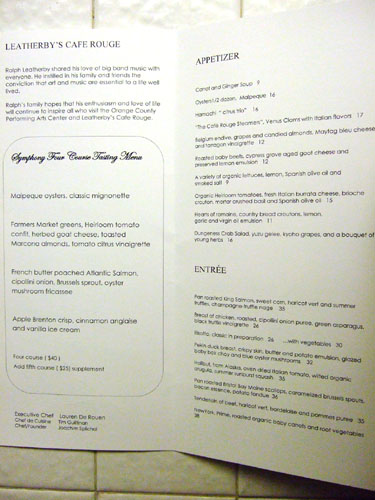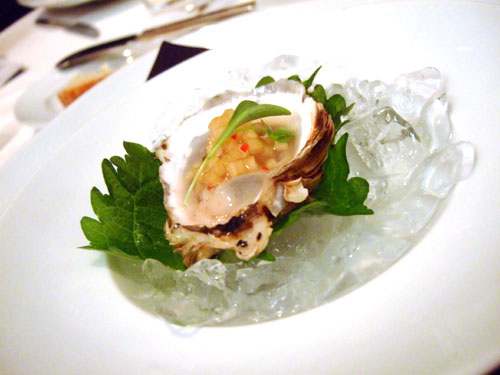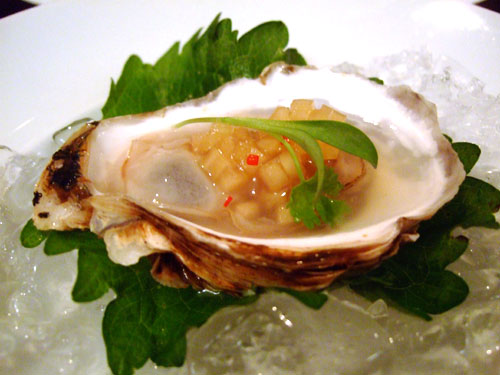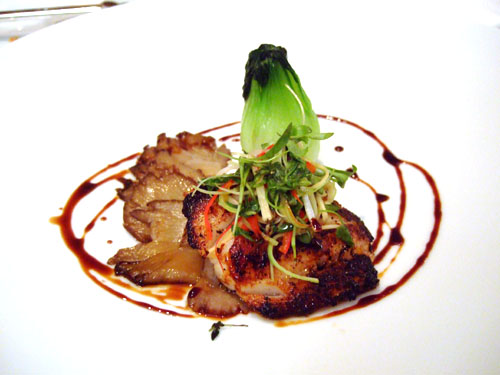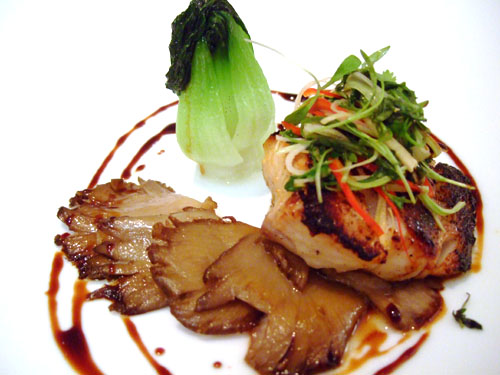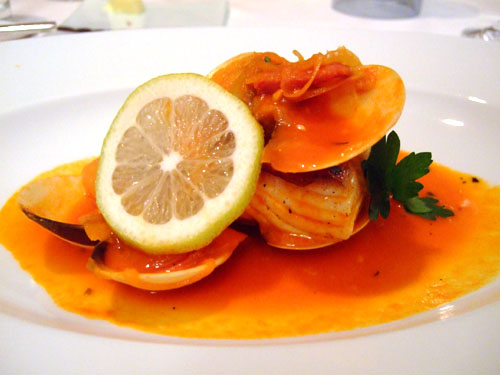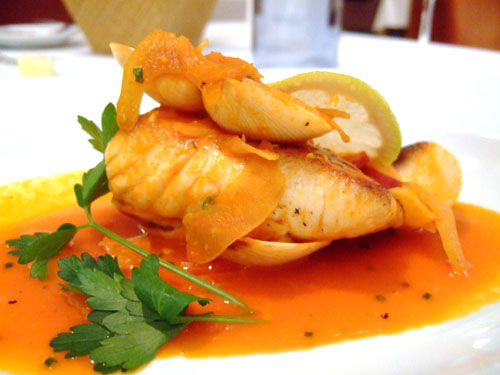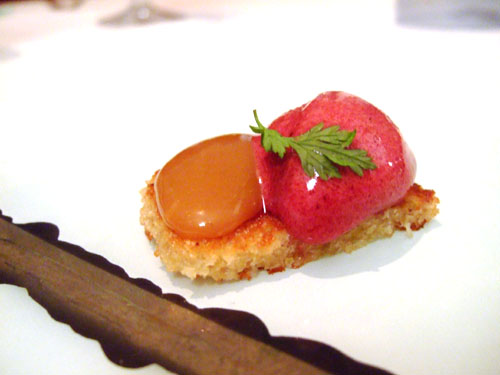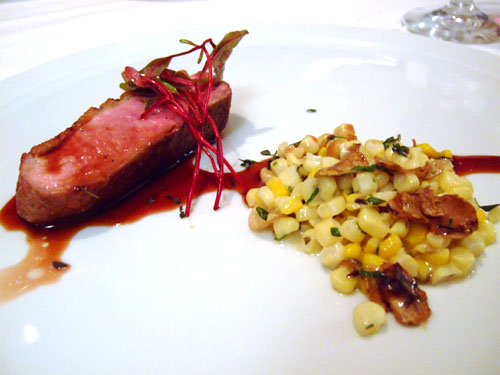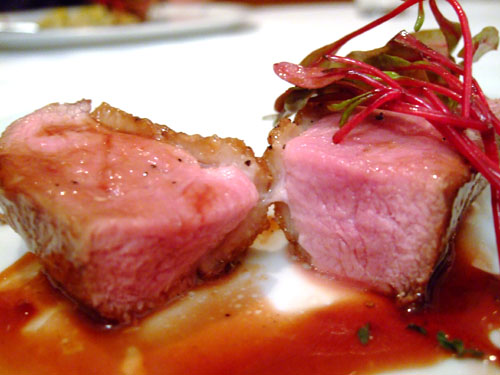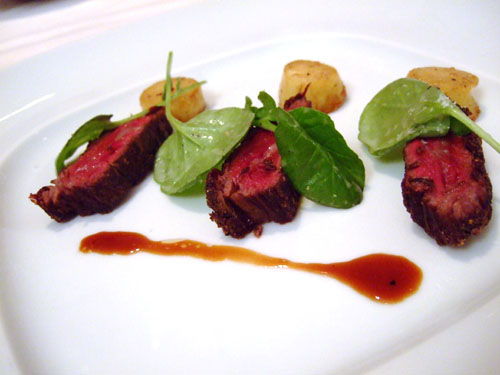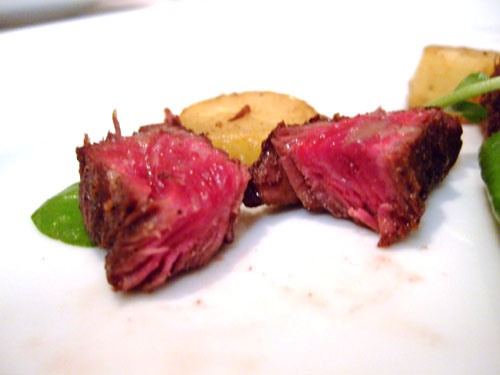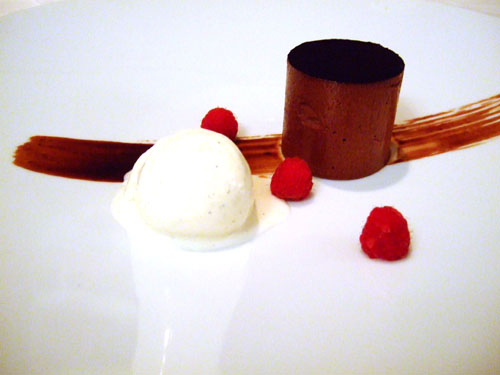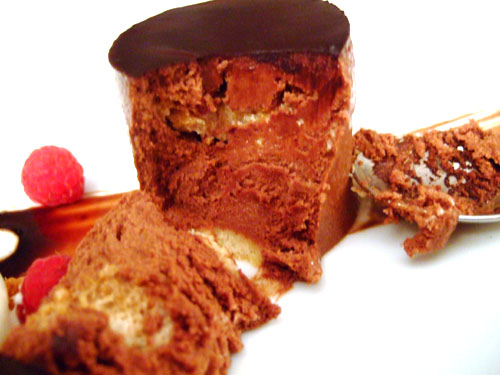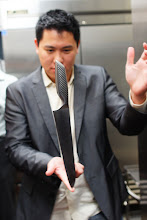218 N Rodeo Dr
Beverly Hills, CA 90210
(310) 247-8939
With an impending second visit looming at the end of May, I decided to repost the review that launched my food reviewing career.
This meal has been something my friends and I have discussed for years, ever since the place was called Ginza Sushi-Ko and run by Chef Masa Takayama. Masa has since moved on to New York, opening Masa and Bar Masa in the Time Warner Building across from Thomas Keller's Per Se. Fortunately, for West Coast sushi lovers, Masa's student Hiro Urasawa has stepped in and taken the restaurant vacated by his former sensei.
Urasawa serves what is known as sushi kaiseki. Kaiseki is a type of Japanese meal consisting of numerous small courses; it originates from the light meal served in a Japanese tea ceremony. These courses are followed up with individual pieces of sushi. Keep in mind this is not Americanized sushi (no California rolls here) nor is it even your local sushi restaurant. When you come to Urasawa, you put your trust in the hands of Urasawa-san, the only menu you get is a drink menu and even that is limited to a few choice selections.
The restaurant is located in an unlabeled building. To enter take Wilshire and turn onto North Rodeo then make an immediate right onto Dayton way. There nestled in this nondescript street is an equally nondescript building with an underground parking garage. Despite the bland looks check out the directory and you will see Urasawa in good company. There nestled among endless identical hallways sits this darkened corner that stands out from the rest. Behind the curtained alcove lies the Mecca of sushi on the West Coast.
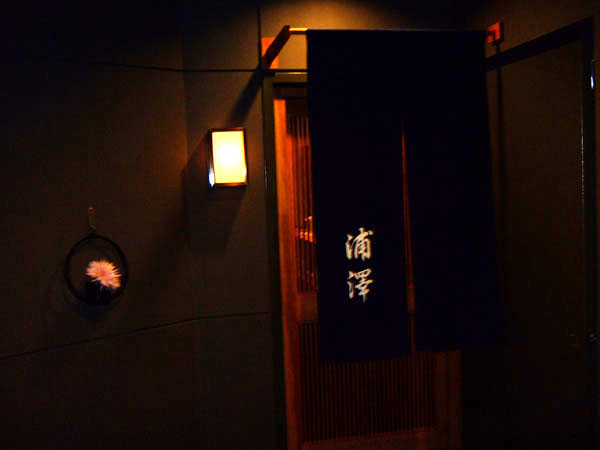
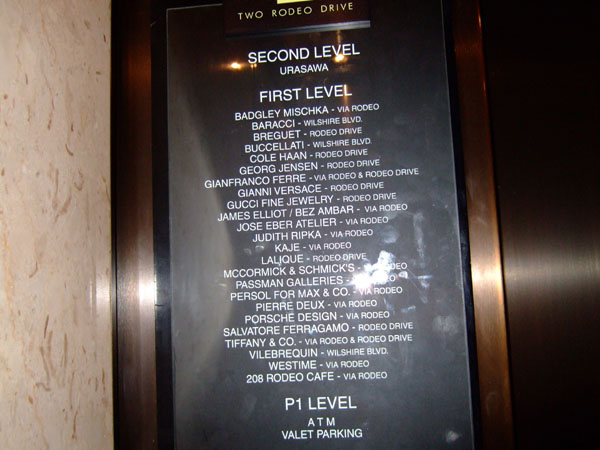
Upon entering one is greeted by a simple yet polished dining area, a well lit bar with functional chairs and neatly folded place settings, the chef's work area where all the magic happens with a case of fish fresh from the market, a curtained kitchen area where unnamed servers do much of the prep work, a shelf running parallel to the bar where drinks are stored, and a table for those seeking a more private dining experience. The wood of the bar area is sanded daily and the feel reflects that loving attention.
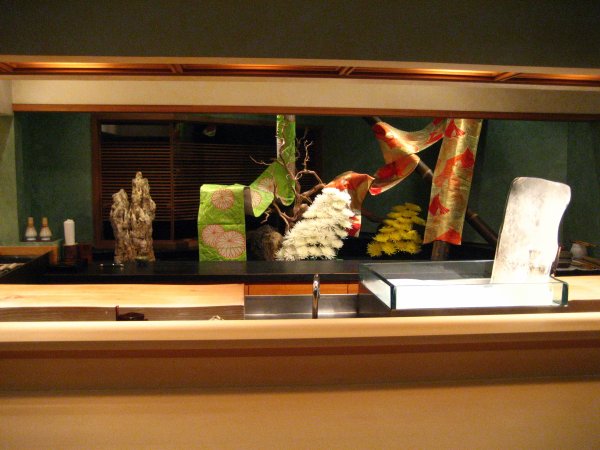
As soon as the hostess offered, I promptly took a corner seat at the bar ignoring a companion's inquisitive glance at the lone table to the side of the room. If you've come to Urasawa it is as much to admire the artistry of the chef, as it is to sample the transcendent results. Not to mention Chef Urasawa is an affable host who engaged us in conversation throughout our meal. I noticed he focused mainly on speaking to us and while I'd like to think this was a result of personal charisma I'd wager it has more to do with proximity to his work area.

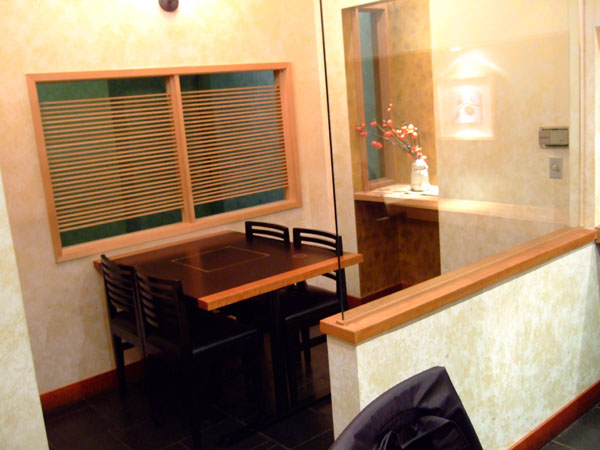
Prior to the start of our meal Urasawa-san asked us a few simple questions. If there was anything we did not like or if there was anything we were allergic to. He also asked if we were Chinese or Japanese and was a touch surprised to find we were Chinese even going so far as to note that I look like his younger brother. He also took down our names; I believe this is to keep track of who we are and what we have eaten so that next time we return he can create a different masterpiece for us.
There were two other parties dining at Urasawa that night, a group of Cantonese people who I gathered were regulars and a group of tourists from Australia. Now normally I would take it as a bad sign if there are no Japanese people were at a sushi restaurant, however Urasawa cannot be judged by such stereotypical standards.
After we finished the pleasantries we ordered the first round of drinks. Having done a bit of homework before coming I was set on trying the Kubota Manju, but was saddened to hear they had run out. Fortunately they did have some of the smaller flasks so we promptly ordered two. The sake was clean, crisp and refreshing with only a whisper of alcohol. Surprisingly it lacked the slightly sweet flavor I have noticed at subsequent tastings. We had a second sake midway through the kaiseki part of our meal. This was a bit sweeter but the flavor seemed to give way to an astringent herbal flavor I wasn't so fond of.
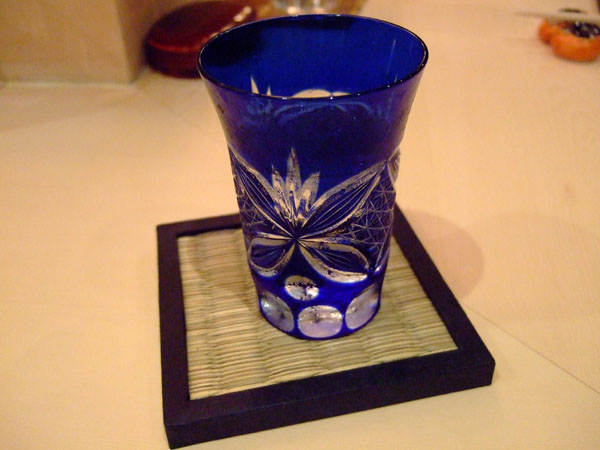
Now then onto the reason we were there and you are here, the food.
Toro Tataki with Orange Ponzu, Radish and Scallion:
My worry with radish in general is that its earthy flavor will overpower whatever it is paired with. The first bite this wasn’t the case as I received a pleasant mouthful of oil and cooked fish with a bit of citrus zest and the sweetness of the onion. The second bite sadly the radish came to the fore and overpowered the fish a bit.
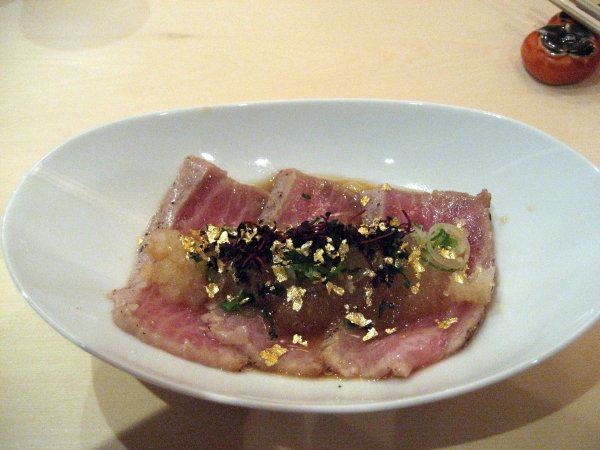
Chawan-Mushi with Uni, Ikura, and Shrimp:
This dish had a nice harmony as no one flavor overpowered the others. The roe added the occasional explosion of sweet brine while the custard provided a nice creamy base with the flavor differing from bite to bite. This dish worried most of my companions who hadn't acclimated to uni yet; however, I believe this may be the catalyst that changes that. Damn no more free uni for me.
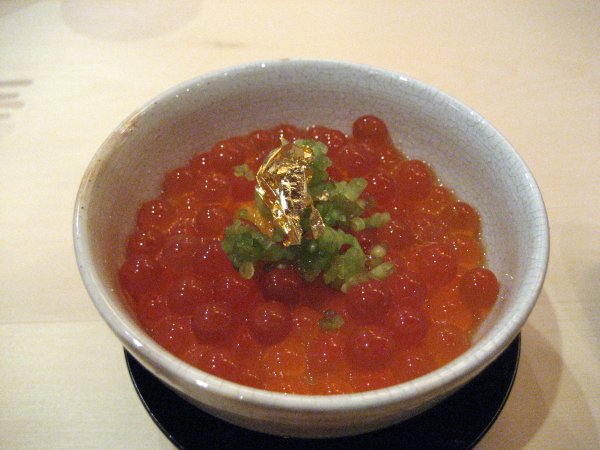
Sashimi of Toro, Snapper, and Orange Clam:
This was one of the most beautiful dishes 6 perfectly prepared pieces of seafood on a block of ice carved by Urasawa-san himself (who knew he was multitalented). Note the young apprentice in the picture. Urasawa remarked that he used to be the one standing there when Masa Takayama ran the place. Urasawa then joked his apprentice might become the master when it was his turn to go to New York. One of my companions and I actually got chastised because we reached for the dish before it was placed before us. To be fair, the process is as important as the actual eating and we were foolishly depriving ourselves of part of the luxury by being hasty. The toro was fairly iconic, minimal tendon and other undesirables while plenty of marbling and flavor. The snapper was a bit lighter in flavor and the connecting tissues holding the pieces of fish together seemed a bit looser than the norm. The orange clam had the scent of the ocean that turned my friends off to it originally, but the flavors were muted by the sweetness of the meat. The texture of the clam was not quite crunchy but almost as if the meat resisted until a sufficient amount of force was applied whereupon it snapped cleanly.
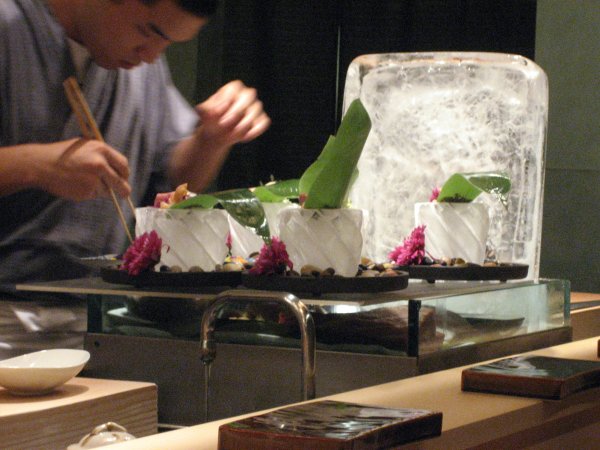

Shrimp Paste in a Turnip with Chrysanthemum Syrup:
For me this was the weakest dish of the evening. Certainly a very pretty dish though. The turnip was almost like a thick jelly in texture while it had only a mild turnip flavor. I expected the chrysanthemum syrup to have a stronger flavor but it just had a very slight flavor reminiscent of chrysanthemum tea served at Chinese restaurants. The shrimp paste had a texture akin to a fish ball and provided most of the flavor. Even then I found myself constantly looking for a bit more taste from the shrimp and being thwarted despite my best attempts.
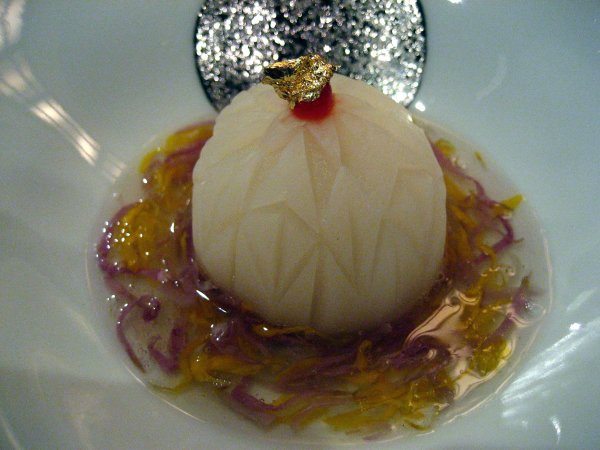
Saga Beef from Kyushu with Sweet Sake, Regular Sake, Yuzu, and Soy:
Oh WOW! Melt-in-your-mouth seems too clichéd to do this course justice. Saga beef is a highly marbled beef that ranks up with Kobe beef in terms of quality. The flavor is delicious similar to Chinese braised beef but richer and more complex. I found it interesting this dish seemed like it had been cooked thoroughly for an extended period. That flies in the face of conventional wisdom of serving beef with high marbling content which says sear and serve lest the marbling melt and run. I imagine this was simmered on low heat letting the flavors seep in at the same time the fat has semi melted but not run off and the connecting tissues have been softened. As a result of this the muscle fibers are barely connected and break on contact with the slightest pressure.
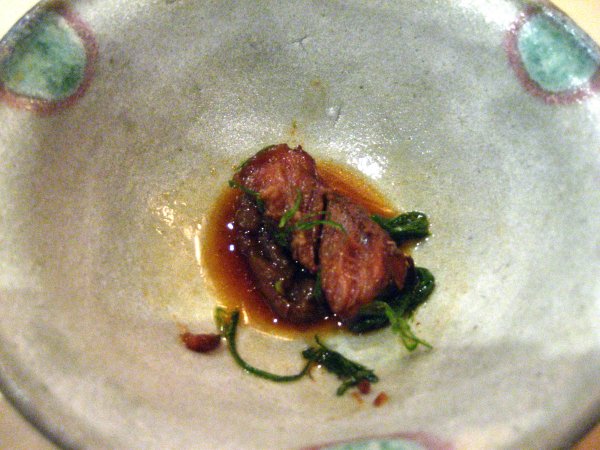
Sea Bass Misoyaki with pickled radish:
The sea bass is firmer than I expected. I expected something more akin to Chilean sea bass soft and fatty. The miso flavor was almost ethereal and I found myself tasting the dish carefully trying to be sure the miso flavor was actually there and not just something I imagined. Having seen the radish overpower a brilliant dish earlier I was a bit hesitant to try the radishes that came with this dish. I was pleasantly surprised to find them sweet and crisp a wonderful accompaniment to the heavier fish.
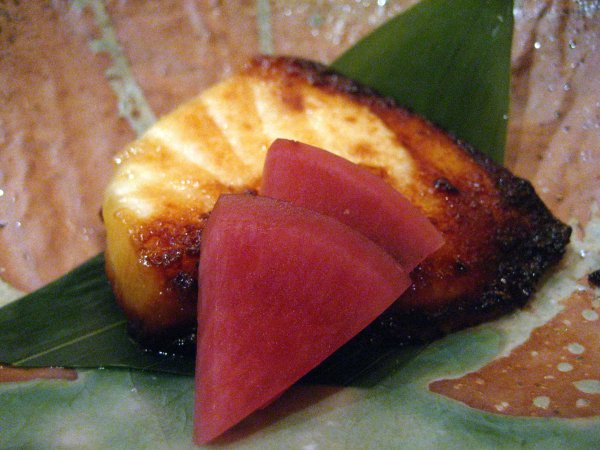
Shabu-Shabu of Foie Gras, Lobster, and Kobe Beef:
Every review of Urasawa I have read includes some form of Shabu-Shabu and we expected no less. There was a slight intermission at this point as Urasawa-San brought out a live lobster and proceeded to prepare it in front of us. In short order he had 10 pieces of lobster tail to go along with servings of Kobe beef and foie gras. The shabu-shabu stock was a mushroom broth that had a wonderfully savory flavor. The hostess came out and gave us some brief instructions on how to prepare the delicacies. The lobster tail had a crunch to it that almost screamed freshness as it should it was alive not 5 minutes before. The lobster was reminiscent of lobster eaten at other restaurants but the texture was slightly crisper and the flavor a touch sweeter and that is what sets Urasawa apart from masses. The Kobe beef had the wonderfully fatty flavor that it is renowned for and my mouth clamored for more after finishing them. The biggest surprise was the foie gras, normally nobody in my dining party aside from me touches the stuff and I do it only reluctantly. This one dish changed that for everybody. Hands down the overwhelming favorite, the lightly cooked foie gras seemed to absorb some of the stock leaving it slightly swollen and very soft. Upon chewing it fairly explodes in the mouth with a sweet rich unctuousness that settles like a blanket across the tongue, with none of the heaviness or gaminess one might expect from the dish. And not wanting to waste a thing we quickly quaffed the mushroom stock, which had since been infused with oil from the foie gras and Kobe beef.
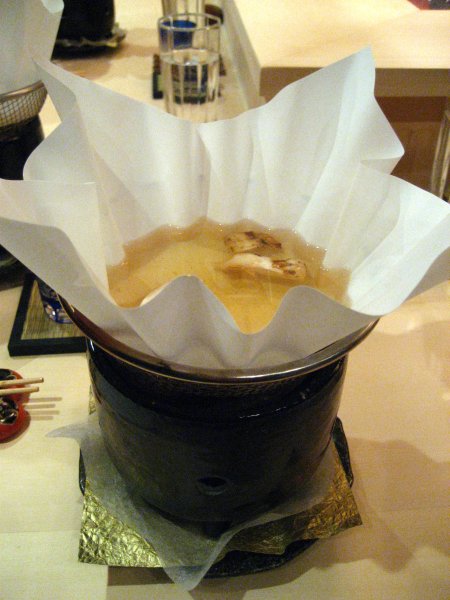
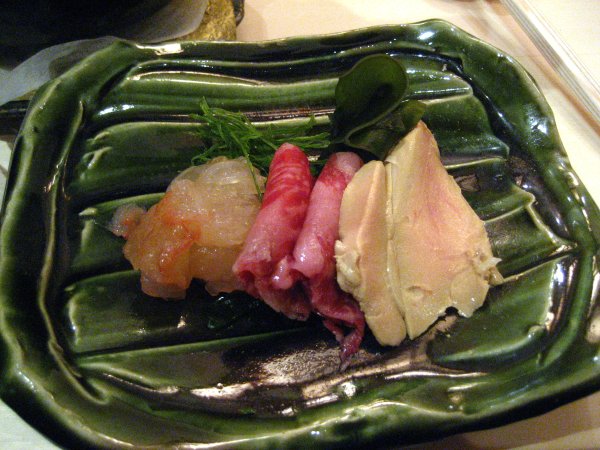
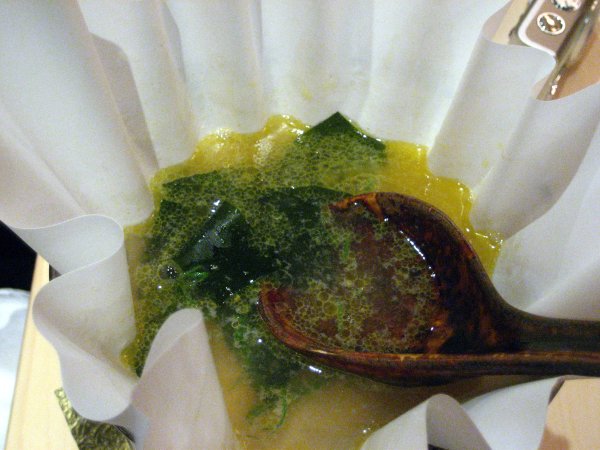
That concludes the kaiseki part of the meal and we switched gears beverage-wise as well. At the last major sushi meal my group enjoyed we brought a bottle of Cristal. This time we went with a bottle of 1993 Dom Perignon. This may be the finest champagne I have had in my life. I am partial to sweeter sparkling champagnes demi-sec the like. This was a brut that had some flavors reminiscent of the 1998 but overall a far more complex vintage, with a taste of minerals as well as hints of piquant sweetness and a nose like that of a fine Sauternes.
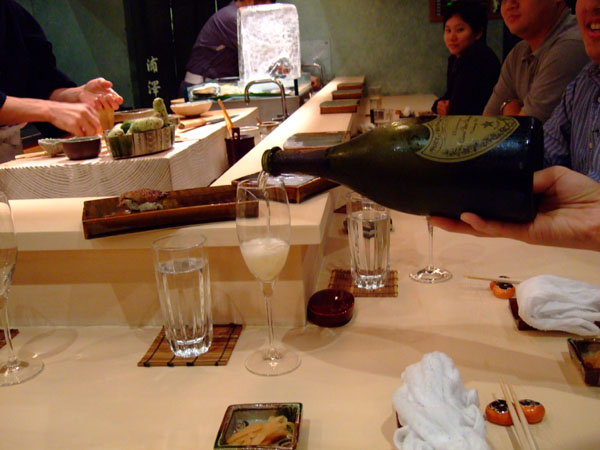
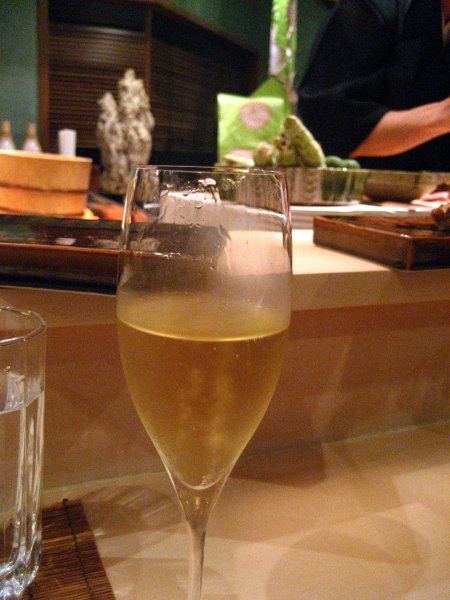
Up to this point my friend and I had been incessantly taking pictures and constantly asking questions to Urasawa-San. He took it all in stride answering our questions with aplomb and asking if we were writing for Chowhound. Unlike most places, Urasawa made each piece of sushi and served us one after another rather than making all five and serving us simultaneously. In fact, when he started making the sushi he warned us "use hands" and "eat within 10 seconds for optimum flavor." While this was spoken lightly and with a smile I sensed the serious undertone in his voice and expression. He truly believed if we tarried too long taking pictures we would miss out. I wonder if there isn’t the obsession with quality of a master craftsman in there as well. In fact for the ikura he specified to eat immediately and seemed truly dismayed my companion didn't. He looked to me and said sternly no more pictures and that I should use the ones already taken. Naturally, I trusted his advice and happily acquiesced.
Toro - Fatty Tuna:
Does this redefine toro? Yes it does. Urasawa-san doesn’t do anything different, he just does it better!
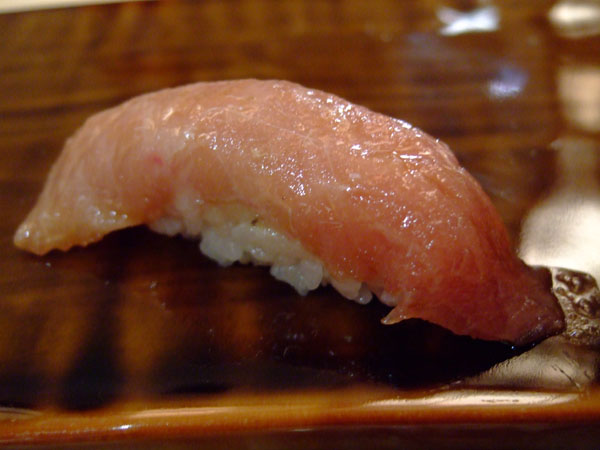
Maguro - Bluefin Tuna:
This was almost marbled enough to be confused with toro. The texture was softer than normal maguro, but the fish had a distinct flavor I couldn’t quite identify.
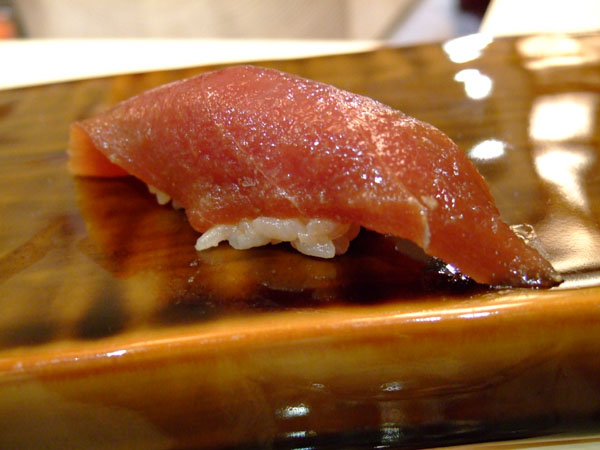
Cooked Toro - Fatty Tuna:
The cooking softens the tendons and melts the fat creating an almost gummy texture. The fish also had a wonderfully charred BBQ taste.
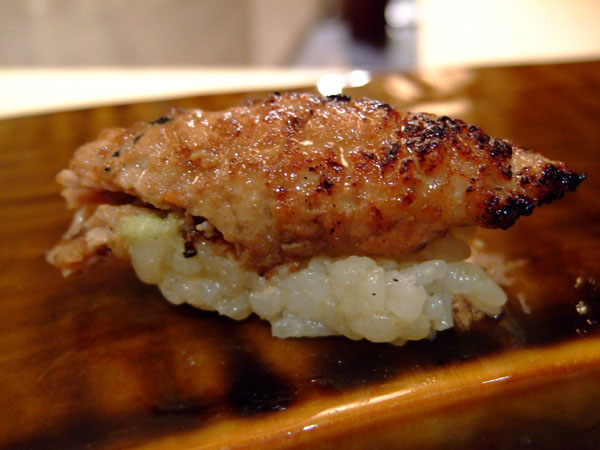
Aji - Spanish Mackerel:
This was my first experience with raw. I think this has more to do with naming confusion than inexperience as I have heard both sawara and aji referred to as Spanish mackerel. At any rate, I thought the sushi had a lighter oiliness than what I am used to.
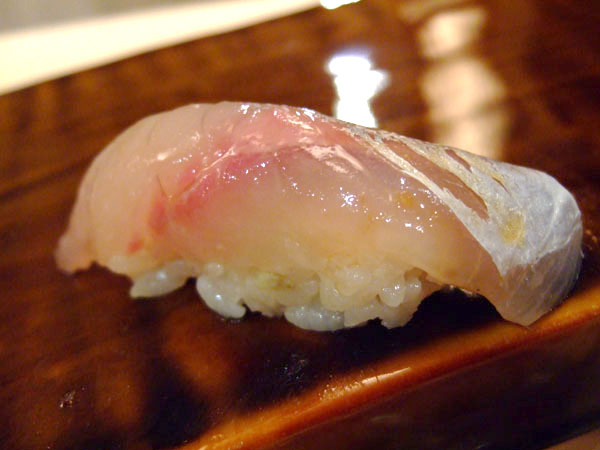
Tai - Snapper with Yuzu Zest:
This was slightly different from the sashimi. The nigiri was topped with yuzu zest and a light soy or ponzu that gave it a bit of saltiness as well as a refreshing flavor. However I preferred the texture of the earlier snapper sashimi.
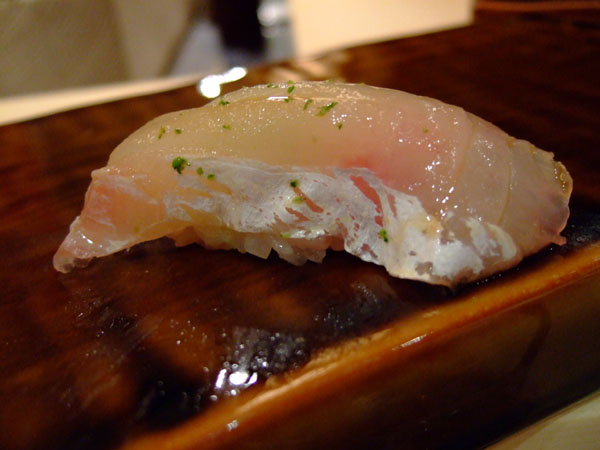
Pike Mackerel:
I swear I had this in Tokyo. This was a thin fish with a deep red color and almost a cherry-like flavor.
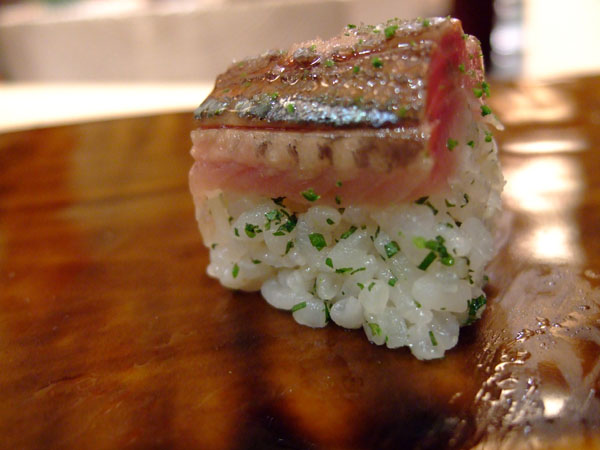
Shira Ebi - White Shrimp:
These are small white shrimp rather than the single large amaebi. The shrimp have a much softer texture and turned almost creamy upon mastication, something I have only experienced with ika previously. All things considered I prefer the taste and texture of simple sweet shrimp.
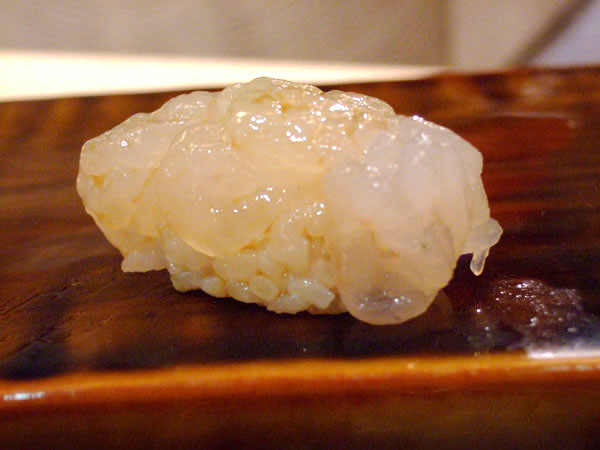
Japanese Mackerel:
I love the color pale white flesh with a strip of vibrant red. If not for the skin I could mistake this for snapper easily. However all that changes once you pop this in your mouth. This is quintessential mackerel, oily and fishy.
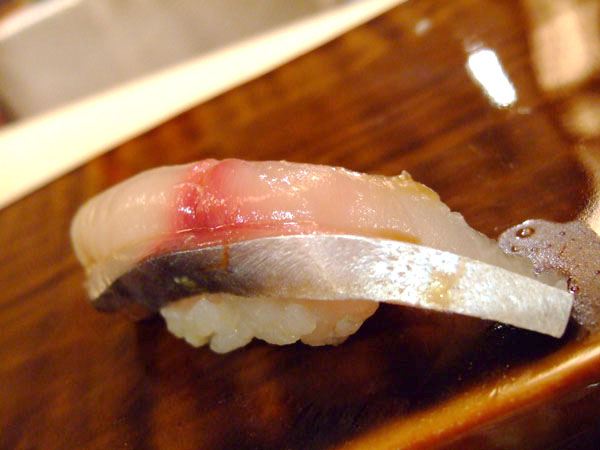
Orange Clam:
More orange clam. Note the fine cuts in the surface. I wonder if this is to help soften the texture and make the meat easier to chew. One of my dining companions noted that he is starting to appreciate orange clam. I consider it high praise for a restaurant to change my opinion of a given dish or ingredient one time in an evening. Urasawa did that many times throughout the night
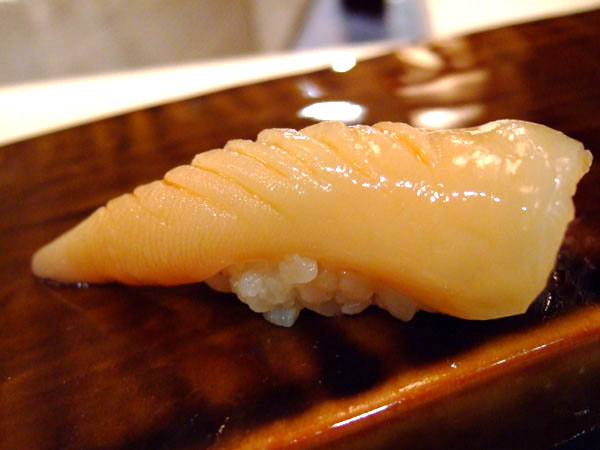
Sayori - Needlefish:
A very unique looking nigiri. Mostly white flesh with a single accenting stripe. The texture is crisp but firm and the flavor is quite mild with just a hint of fishiness and not in an unpleasant sense either. I would love to have this again somewhere but I get the feeling it isn't widely available at your local sushi joint.
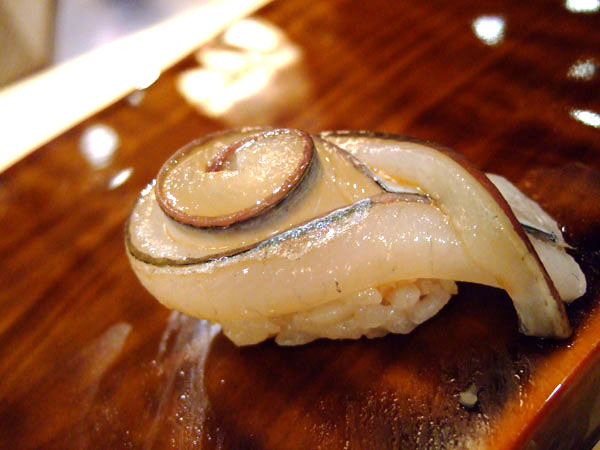
Shitake Mushroom:
When he handed us this one I was a touch surprised. I love shitake mushrooms but I never expected to be served one as a piece of sushi. However the crisp fresh shitake paired very well with the wasabi.
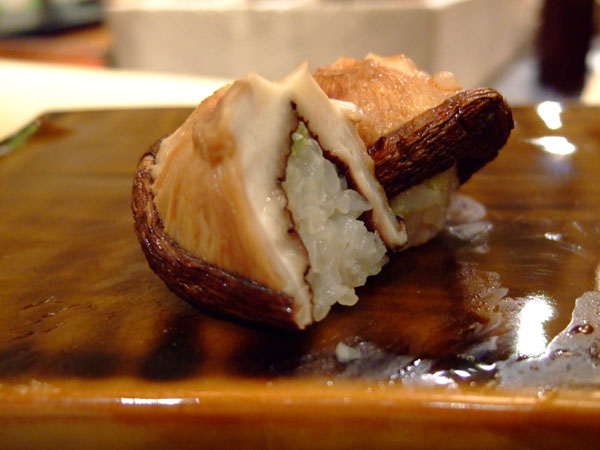
Kohada - Japanese Herring:
Again the light cuts with the knife. I liked Kohada from the first time I tried it and this was no exception. One thing of interest is that many of the fishes served here look totally raw. Perhaps the milder flavors have to do with the fact that the fish isn’t soaked. Normally the kohada I eat is seasoned with salt and soaked overnight. Like with the Spanish mackerel this was served totally raw. The unique preparation is one of the bits of attention to detail and uniqueness you get at Urasawa.
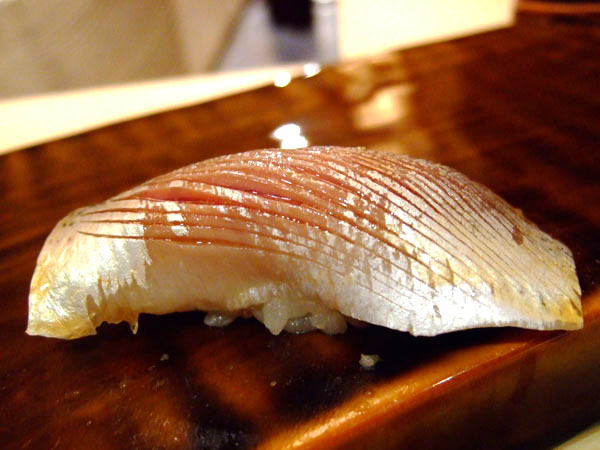
Abalone with Yuzu Zest:
One has to handle a knife in the kitchen to truly appreciate the difficulty of the fine cuts made by Chef Hiro. I watched, as he deftly seemed to brush the knife over the surface of the abalone to make the slight cuts. I have always wondered why they do that for certain fish like Kohada, Ika, and Abalone.
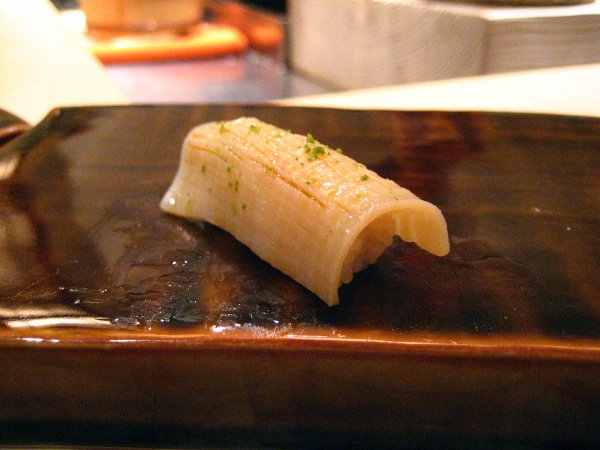
Sea Eel:
Grilled and lightly flavored with sweet sauce. Although I enjoyed this, I have always preferred the meatier texture of freshwater eel to saltwater eel.
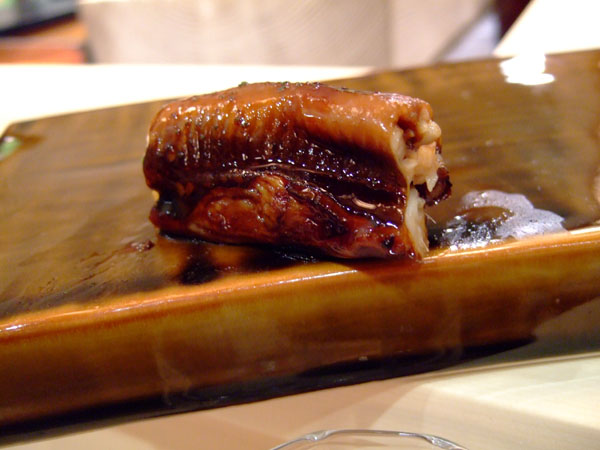
Mirugai - Geoduck:
I have had this at a number of sushi restaurants and also many times as a child at home. Interesting to note, at home we at the trunk of the clam, thinly sliced served raw. Urasawa-san seems to serve the meat from the shell, which we always used to make soup. Compared to the other clams we had this evening the flavor is much milder. Also the texture is more yielding yet has a tendency to return to its original shape
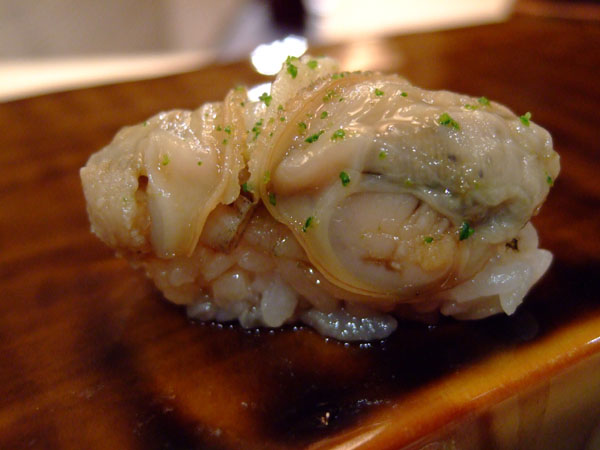
This marks the end of the official dinner service. However this is not your normal restaurant and rather than just move onto dessert, the chef asks if we are full. Now I was sated, but I thought to myself how often can I eat this well and looking around I saw similar feelings on the faces of my dining companions. So we smiled widely and asked for more. Being the gracious host he was Urasawa-san asked what we liked best and we joyously responded "TORO!"
Toro:
More of the same, which isn’t a bad thing. Urasawa-san apologetically noted this is the last of the toro for the night.
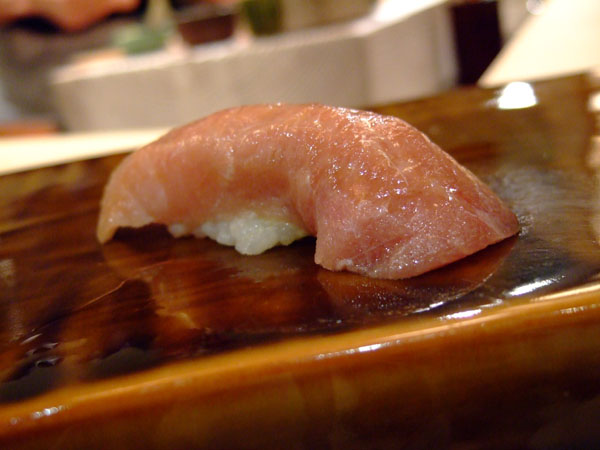
Japanese Skipjack:
Looking back at the notes, we recorded this fish was somewhat soft and sort of middle of the road for flavor. I think we were just getting tired of analyzing by this point.
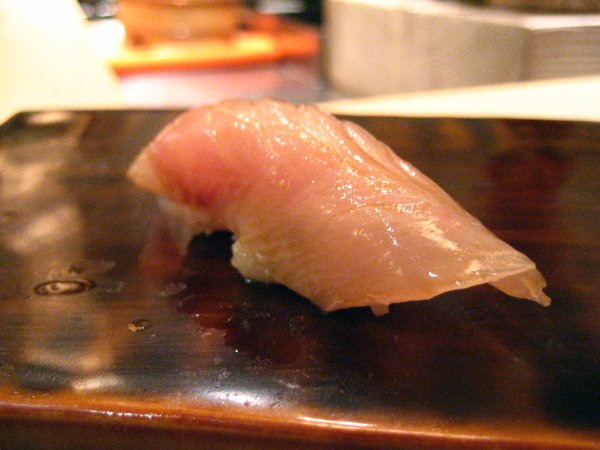
Toro Roll with Scallion and pickled radish:
But wait there’s more. Seeing how much we loved toro, but being unable to serve everyone another piece of nigiri, Urasawa san served us a toro roll. I remember this having real crunch and having a flavor like spring rain from the scallion. This was the perfect sushi to give us a second wind and restore our energy levels that had no doubt waned over the course of a 4-hour meal.
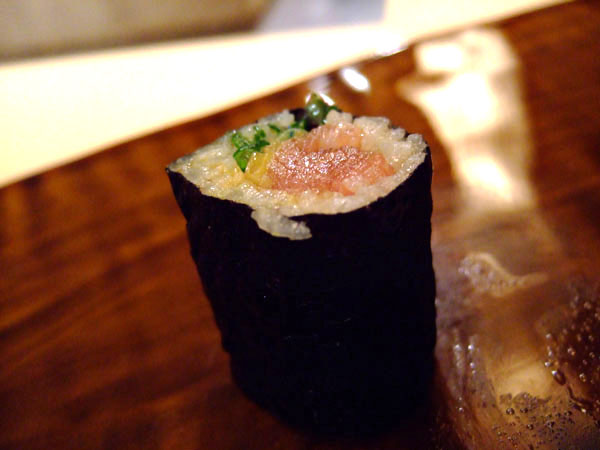
Ikura - Salmon Roe:
This was the dish we were asked to eat immediately "no pictures". And it was divine. The cold salty explosions serve as a wonderful counterpoint to the warm rice. The yuzu zest not only made gave a wonderful visual contrast to the perfect spheres of exploding flavor but imparted a unique twist to the morsel.
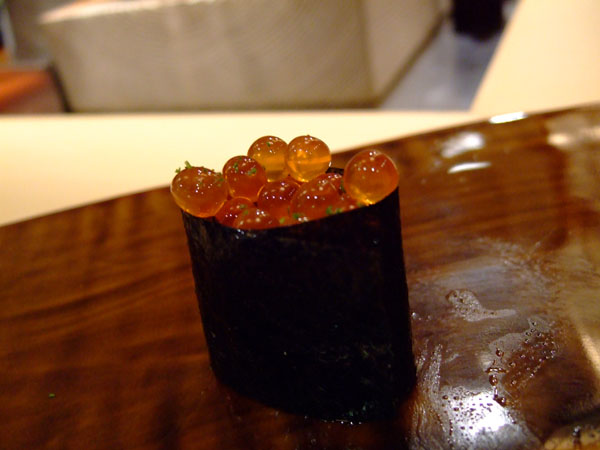
At this point Urasawa-san again asked if we had enough. This time we hesitated. Were we satiated? Certainly. Would we eagerly stuff ourselves further? Without a moments hesitation. Finally good manners won out and we politely but reluctantly declined further servings of sushi.
Tamago - Egg:
This looked like a piece of pound cake so I was surprised to find this was actually tamago nigiri. I never order this from sushi restaurants. After all the exotic fish to offer us egg seemed a touch odd. Perhaps seeing our confusion Urasawa-san gently explained a sushi restaurant's quality can be judged by its tamago. If so than Urasawa is truly brilliant. The tamago was airy and delicate with a light sweetness. This dish served as the perfect close to the sushi and the beginning of the desserts.
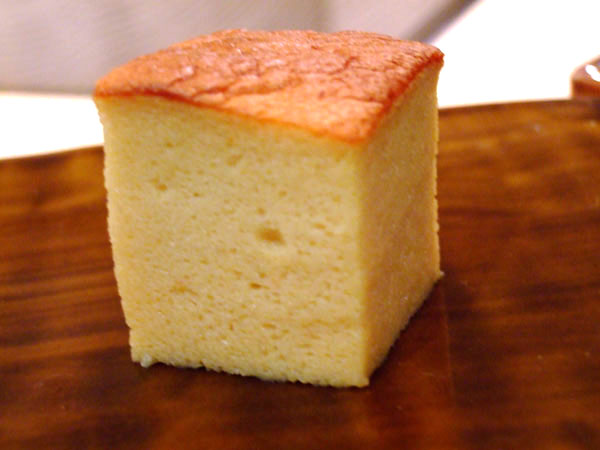
Mountain Pear, Apricot with Shiso Leaf, Grapefruit Jello:
Served in a little red and gold-checkered box this was the first official dessert. Each fruit was sweet in its own way. I liked the mountain pear the most (the little red spiny ball). I tend to shy away from shiso-flavored dishes because I find the taste of shiso a bit too strong. The grapefruit jello was good but having recently come back from Japan I had one there that was far better, which dulled this one's luster.

Sesame Ice Cream with gold, soy milk, and black sugar:
The essence of sesame distilled into ice cream form.
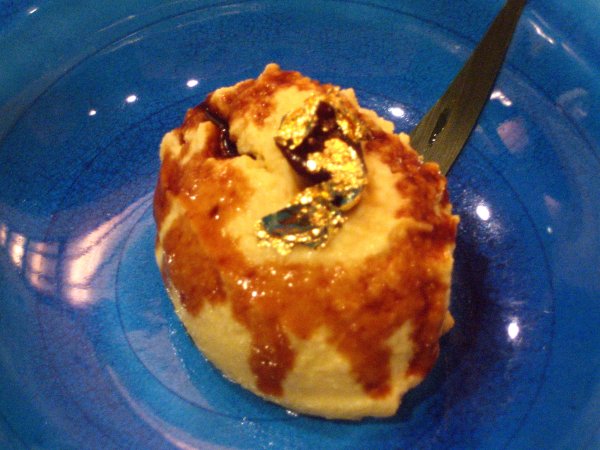
Green Tea Macha:
Foamy warm green tea. Reminds me of the macha I had in Japan. I like the lightly bitter and creamy combination.
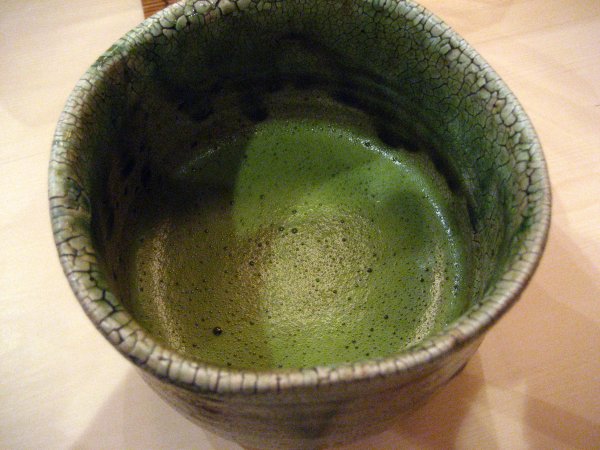
Roasted Green Tea:
And if one tea service isn’t enough for you here is another. This almost looked like a tea served in a Chinese restaurant. The roasting brought out a stronger bitterness but after having one tea the added bitterness was fairly welcome.
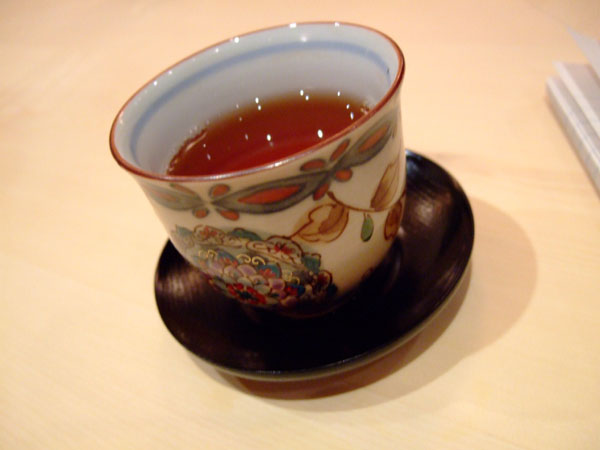
Tools of the Trade:
These aren’t your normal kitchen knives. I didn't pay enough attention to which knife he used when, but I am sure each has its uses. Additionally, Hiro used to serve Fugu and supposedly had a $2000 knife specifically for that one purpose. Sadly, fugu is no longer on the menu at Urasawa, after being fined by the government a number of times; he has given up serving the delicious yet highly poisonous (if incorrectly prepared) fish.
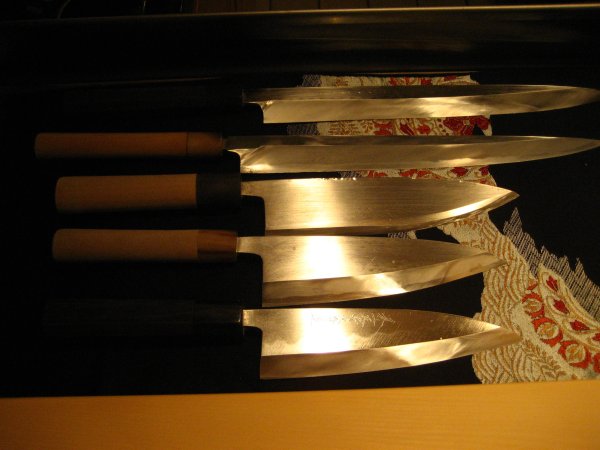
A couple final notes, dining here is strictly by reservation only (two walk-ins were turned away by a polite and firm Urasawa-san. This is for a number of reasons, there are only 10 seats at the bar and a table for 4, the restaurant is not equipped to handle a large crowd, and in my estimation the quality of the meal would suffer tremendously. The second reason is with a meal of this caliber, the ingredients must be fresh, and in fact one of my companions told me that Chef Urasawa buys his ingredients fresh that morning. Also prepare to have lots of time (~4 hrs) although one hardly notices the passage of time and for me the meal passed all too quickly. Finally a warning on the price, it is $250 per person pre tax and tip and for those who treasure the unique dining experience Urasawa offers this is a bargain compared to others, Masa and Kyubei come to mind. However, for many the sticker shock on such a meal can outweigh the pleasure and that is a tragedy for the diner, the chef, and the potential foodie who could have truly appreciated the pleasure.
The dining party poses for a final shot with Urasawa-san. Thanks to Kevin for the use of some of his pictures.
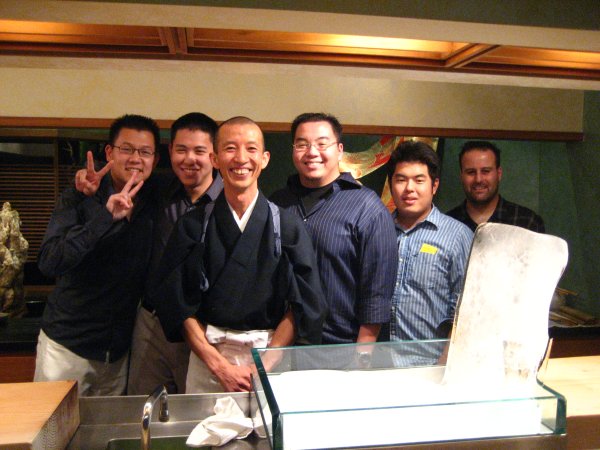
In closing, Cheers!
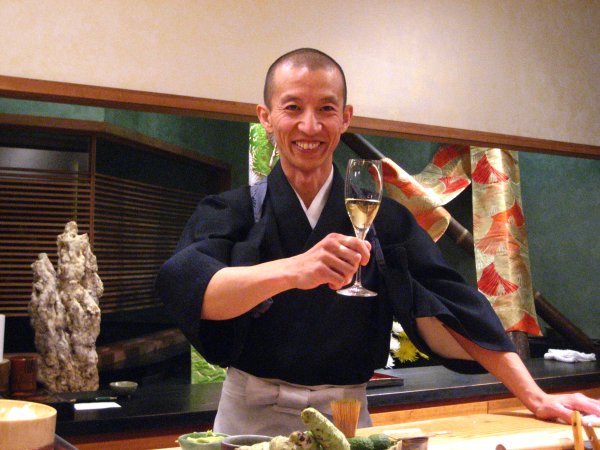
Read more.



